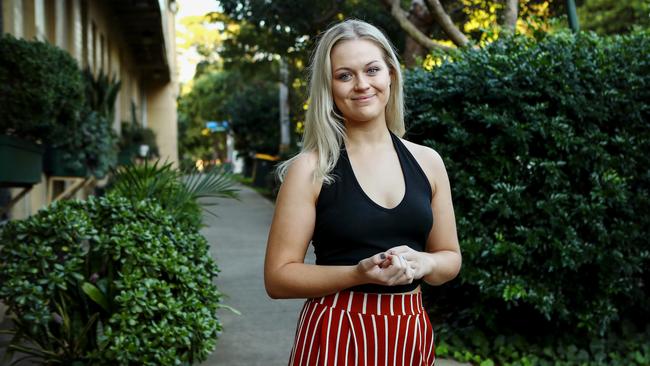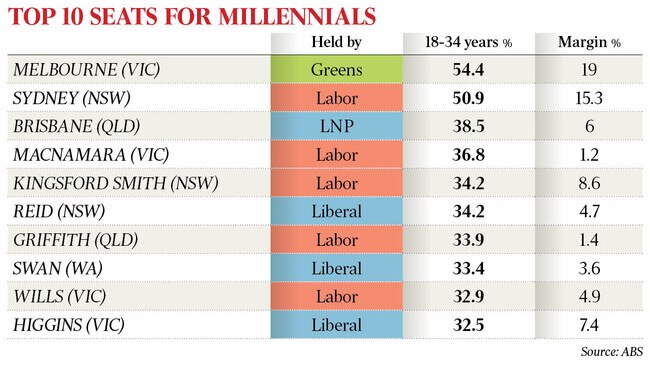Millennials to make their presence felt in marginals
A flood of millennial voters new to the electoral roll will challenge Coalition attempts to hold several marginal seats.

A flood of millennial voters new to the electoral roll will challenge Coalition attempts to hold several marginal seats at the federal election, which is shaping as a generational battle over the future of the country.
Bill Shorten has unveiled a number of policies aimed at mobilising younger voters to get behind Labor’s plan to tackle housing affordability by grandfathering negative gearing and to bring the budget back to a more sustainable footing by cutting retirees off from refundable excess franking credits, which will save taxpayers $56 billion over a decade. Labor is also targeting young voters by promoting renewable energy, free TAFE places and expanding funding for apprenticeships.
Scott Morrison has staked his return to the prime ministership on a campaign to defend older voters from the opposition’s so-called retirees tax and its plans to raise taxes on superannuation.
An analysis of Australian Electoral Commission data by The Australian reveals 62 electorates with an over-representation of voters aged between 18 and 34. Of these, 45 are held by Labor.
Fifteen of the seats are held by the Coalition. Of these, five are held on a margin of less than 5 per cent and vulnerable to a rise in millennial antagonism to policies seen to be aimed at protecting the interests of the baby boomer generation.
The intergenerational war comes amid the highest enrolment rate in history — at nearly 97 per cent of eligible Australians — which has been supported by a record enrolment rate for young Australians, at 88.8 per cent.

The youth enrolment rate was bolstered by 70,000 voters who enrolled in the past few weeks before rolls closed for the election. About 100,000 Australians, two-thirds of whom were under 25 at the time, were added to the electoral roll ahead of the same-sex marriage postal vote.
Talia Sigsworth of Sydney will be among the army of young voters casting their ballot in a federal election for the first time and says she has done her research.
The 20-year-old musical theatre graduate has chosen to vote for Labor because of the party’s health policies and tax cuts for low-income earners, but said most of her friends would base their votes on who their parents chose to elect. “It’s not a decision I’ve taken lightly,” she said.
Her decision to vote for Labor was made because of a belief that young people tend to get “neglected” when it came to health. Ms Sigsworth has a rare connective tissue disorder which has led to several broken bones. The costs of treatment will soon be borne by her as she will be removed from her parents’ health insurance policy when she turns 22.
Grattan Institute budget policy program director Danielle Wood said policy decisions to reduce the tax burden on the growing cohort of older Australians meant younger people were paying more.
“A series of tax policy decisions over the past two decades — tax-free superannuation income in retirement, refundable franking credits and special tax offsets for seniors — have meant we now ask older Australians to contribute a lot less than we once did,” Ms Wood said. “Younger households today are underwriting the standard of living of older households to a much greater extent than in the past.”
Among the seats where young voters will be crucial is Reid in western Sydney. It counts 34.2 per cent of its population as being aged between 18 and 34 — far above the national average of 24.5 per cent. It is also the sixth-youngest seat in Australia and is held by the Liberals on a margin of 4.7 per cent.
The West Australian Liberal-held seat of Swan, held by 3.6 per cent, is the eighth-youngest electorate, with 33 per cent of its population in the millennial age bracket. Julia Banks’s vacated seat of Chisholm is held on a 3 per cent margin and is one of the 40 youngest electorates. Christian Porter’s seat of Pearce is held on a margin of just 3.6 per cent, and David Coleman’s electorate of Banks has a buffer of just 1.4 per cent. Both are over-represented with younger voters.
Additional reporting: Jessica Cortis



To join the conversation, please log in. Don't have an account? Register
Join the conversation, you are commenting as Logout